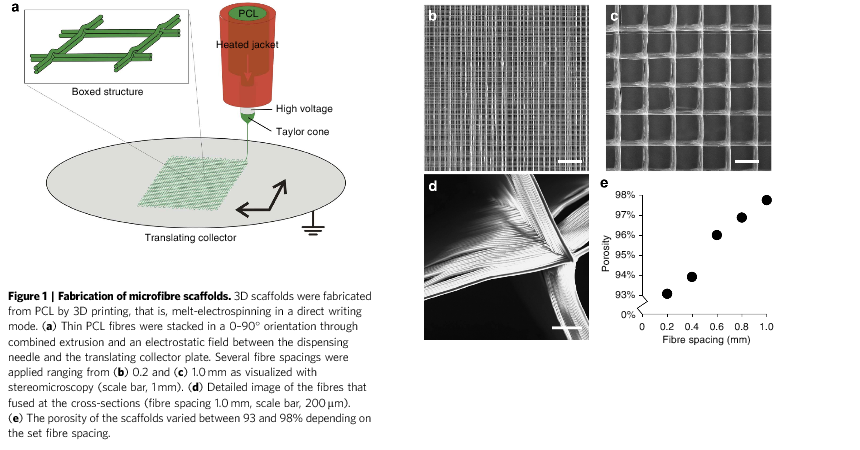
Posted on 05/01/2015 11:22:09 PM PDT by 2ndDivisionVet
There is tremendous progress being made within the area of 3D bioprinting. In fact, there are companies working to print human organs as we speak, and within the next decade such organs may, if we are lucky, be available for human transplantation. With that said we still are a ways away from such an accomplishment. There are multiple obstacles researchers must first overcome. When considering the organ printing space in general, the printing of complicated vascular networks is the main obstacle currently preventing progress. On the other hand, when printing cellular musculoskeletal tissues the main obstacle in this space is actually the lack of strength inherent in hydrogels.
Hydrogels currently in use are unable to meet the biological and mechanical requirements for the printing of numerous human tissues. That’s until recently. In a recent article published on Nature Communications on April 28, called ‘Reinforcement of hydrogels using three-dimensionally printed microfibers,‘ researchers at Queensland University of Technology, in Brisbane, Australia, figured out a viable method of creating far more robust and stiff hydrogels.
The researchers — Jetze Visser, Ferry P.W. Melchels, June E. Jeon, Erik M. van Bussel, Laura S. Kimpton, Helen M. Byrne, Wouter J.A. Dhert, Paul D. Dalton, Dietmar W. Hutmacher, and Jos Malda — found that by using a new 3D printed high-porosity microfiber technique, they could increase the stiffness of a hydrogel/scaffold composite by up to 54x, while maintaining an elasticity similar to human tissue.
While nature often uses fiber to strengthen structures, when trying to reproduce such structures in the lab, scientists do not have any way of mimicking this process.
“Such is the case with articular cartilage tissue, which is formed by stiff and strong collagen fibres intertwined within a very weak gel matrix of proteoglycans,” explained Professor Dietmar W. Hutmacher, from QUT’s Institute of Health and Biomedical Innovation. “By bringing this natural design perspective of fibre reinforcement into the field of tissue engineering (TE), we can learn a lot about how to choose an effective combination of matrix and reinforcement structure in order to achieve composite materials with enhanced mechanical properties for engineering body parts.”
In order to successfully harvest human cells, the hydrogel needs to act as a fully hydrated 3D environment which is “comparable to the extracellular matrix of the native tissue,” so that when cells are embedded they are able to repair and regenerate the damaged tissue. The typical hydrogels which are currently being used are oftentimes too weak, or do not present the most conducive environments for the cellular growth.

Using a technique called melt electrospinning direct writing (a form of 3D printing which stacks layers of fibers in a given orientation), researchers have been able to reinforce gelatin metha-crylamide (GelMA) hydrogels with poly(e-caprolactone) (PCL) fiber scaffolds, which have a very high porosity. GelMA, which is currently a hydrogel being put to use within many medical fields, because it allows for matrix deposition of cells, is also rather weak, making it not ideal for bone or musculoskeletal tissue. By reinforcing the GelMA with the PCL, however, fibrous hydrogel composites that are incredibly stiff, resembling that of articular cartilage, or the cartilage often found on the surface of bones, can be created. This composite material also is able to remain relatively elastic.
“We found that the stiffness of the gel/scaffold composites increased synergistically up to 54 times, compared with hydrogels or microfiber scaffolds alone,” explained Hutmacher. “Computational modelling has shown that we can use these 3D-printed microfibres in different hydrogels and a large range of tissue engineering applications.”
By utilizing this melt-electrospinning writing 3D printing process, researchers were able to construct the PCL fibers using micrometer-scale fibers, which would have been impossible to create using other extrusion methods of 3D printing. The filament diameter was able to be as small as 5 microns, which is 1/20th the size of filament used with traditional extrusion processes on FDM/FFF 3D printers today.
In conclusion, this research will likely lead to new approaches to bioprinting numerous human tissues, especially that of cartilage and other musculoskeletal tissues. When human chondrocytes cells (healthy cartilage cells) were encapsulated in the GelMA/PCL composites they were found to be much more responsive to mechanical loading, “which led to significant changes in gene expression in vitro.”
It will be interesting to see what additional progress is made within this area of research, and just how the 3D bioprinting of human tissue may be influenced. Let’s hear your thoughts on this research in the 3D Printed Hydrogel Composite forum thread on 3DPB.com.
We sure do!
Thanks for another informative posting :-)
The new Avengers movie had 3-D printer human tissue technology as one of its subplots.
I learned something during my time in Army Intelligence: If they’re telling or showing you something that seems “futuristic” or beyond belief, they’ve already had it or have been doing it for 20-40 years.
So THAT'S how Soros and Carter stay living.
To me, somehow, this just creeps me out. It makes me realize some things are just better left to God. I'm thinking that at some point, He just goes "No. Stop. That's enough out of YOU."
Soros, maybe. Carter is still drinking Billy Beer.
So I can smoke and drink all I want now and just print off new lungs and liver when the old ones explode.
Don’t forget heroin and crack. New brain and heart.

Later
Thanks 2ndDivisionVet.

Disclaimer: Opinions posted on Free Republic are those of the individual posters and do not necessarily represent the opinion of Free Republic or its management. All materials posted herein are protected by copyright law and the exemption for fair use of copyrighted works.